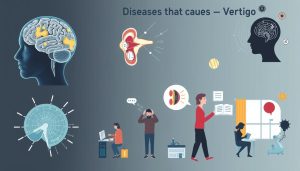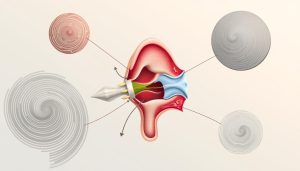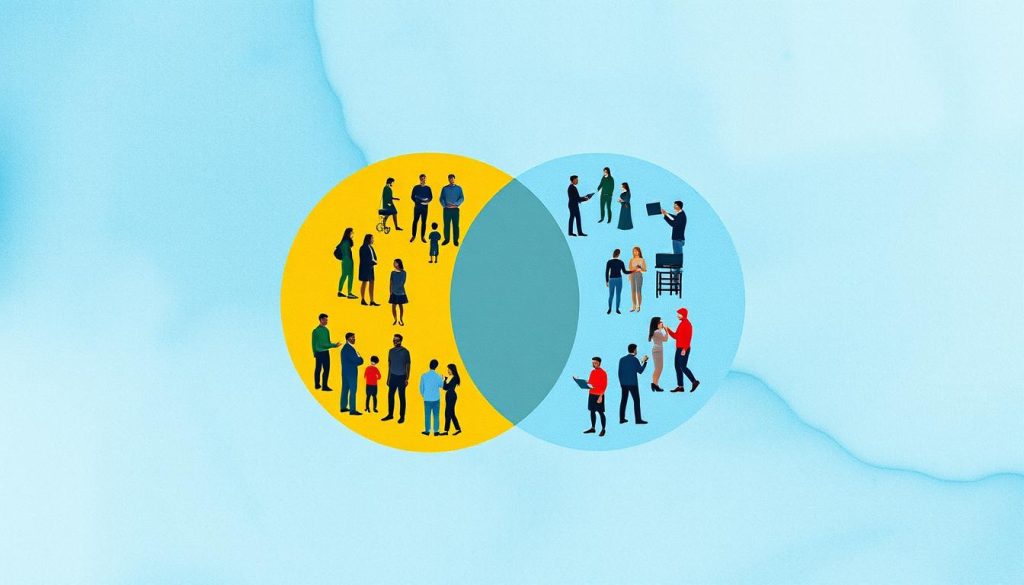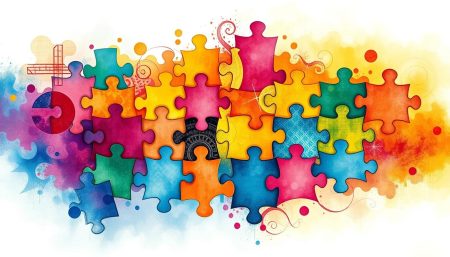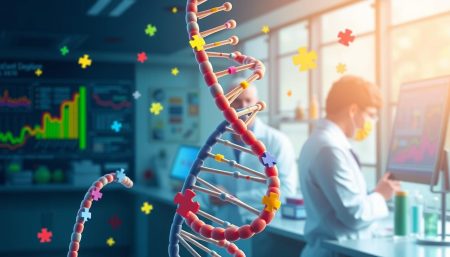The details of autism spectrum disorder diagnostic criteria are key to correctly identifying and helping those with ASD. This article uses trusted sources like the Centers for Disease Control and Prevention and the DSM-5 by the American Psychiatric Association. It aims to explain the basic ASD diagnosis criteria.
By looking at research on ASD diagnosis, we offer a full view of what’s needed for a proper assessment and categorization of ASD.
Exploring autism diagnostic criteria is more than just a formality. It’s essential for a deep understanding needed for effective care. As we dive into these criteria, we show how vital they are for a quick and accurate ASD diagnosis.
Introduction to Autism Spectrum Disorder
Autism Spectrum Disorder (ASD) is a group of conditions that affect how people interact and communicate. It also involves repetitive behaviors. Knowing the diagnostic criteria for autism spectrum disorder is key for early help and managing the condition.
Defining Autism Spectrum Disorder (ASD)
Autism spectrum disorder criteria include behaviors seen in early childhood. These behaviors make it hard for people to interact socially, in school, or at work. Symptoms can vary, but all people on the spectrum struggle with social communication and interaction.
Prevalence and Importance of Accurate Diagnosis
Getting a correct diagnosis is vital. It helps with therapy, education, and fitting into society. The CDC reports more people are being diagnosed, showing the need for accurate tests and plans. A right diagnosis leads to better education and behavior plans, helping with growth.
Knowing how common ASD is and focusing on diagnostic criteria for autism spectrum disorder is important. It helps ensure those with ASD get the support they need. This understanding creates a supportive environment, improving life for those with ASD.
Historical Evolution of ASD Diagnosis
The journey of understanding autism spectrum disorder (ASD) has changed a lot over time. It started with the first descriptions and has grown to the DSM-5 criteria today. This shows how much the medical field has learned about diagnosing and understanding ASD.
From Kanner to DSM-5: The Path of ASD Criteria
Leo Kanner first described autism in 1943. This started a long journey to today’s diagnostic standards. The Diagnostic and Statistical Manual of Mental Disorders (DSM) has updated these standards many times. The DSM-5 now offers a detailed and broad view of ASD, recognizing its many forms and levels.
Understanding Changes in Diagnostic Standards
The changes in how we diagnose ASD show how much we’ve learned. The DSM-5 made big changes, making the criteria more detailed and inclusive. These updates help doctors diagnose better and tailor treatments to each person’s needs. The DSM-5’s move to a single category for autism shows how our understanding has grown.
These changes in diagnosis have been shaped by our growing understanding of autism. As society’s views on autism have changed, so have the diagnostic standards. This shows how important it is to consider the context when diagnosing ASD.
This history helps us understand autism better today. It also sets the stage for future discoveries. It’s a tribute to the hard work of researchers, doctors, and advocates who have worked to understand autism over the years.
Core Components of ASD Diagnostic Criteria
Understanding the core components of ASD diagnosis criteria is key for identifying and supporting those with autism spectrum disorder. These criteria focus on two main areas: social communication deficits and repetitive patterns of behavior.
The first key area is social communication deficits. People with ASD may find it hard to connect socially. They might struggle with understanding and using non-verbal cues, and building and keeping relationships.
The second area is repetitive behaviors. This includes doing the same actions over and over, sticking to routines, and having strong, unusual interests. They might also react differently to sounds or lights than others do.
| Clinical Indicator | Description | Examples |
|---|---|---|
| Social Communication | Deficits in using or understanding social behaviors | Difficulty sharing interests, emotions, or affect |
| Repetitive Behaviors | Engagement in repeated behaviors or speech | Lining up toys, repeating phrases |
| Sensory Sensitivity | Over- or under-reaction to sensory input | Aversion to certain sounds or textures |
It’s vital to recognize these core elements of autism spectrum disorder diagnostic criteria. This helps in diagnosing ASD correctly. It ensures those with ASD get the right help and support for their needs.
DSM-5 Criteria for Autism Spectrum Disorder
The DSM-5 autism diagnostic criteria are key for spotting Autism Spectrum Disorder (ASD). They cover a range of issues with social interaction, communication, and repetitive behaviors. This part explains the details of these criteria, focusing on the specific signs of ASD that need careful checking.
Persistent Challenges in Social Communication
The diagnostic criteria for ASD point out ongoing social communication problems. These include trouble with social feelings, nonverbal signals, and keeping up with relationships.
Patterns of Restricted and Repetitive Behaviors
The DSM-5 also talks about specific behaviors that are repetitive and limited. These might be seen as odd movements, a need for things to be the same, strict routines, or intense interests that are not normal.
Using these DSM-5 autism diagnostic criteria means looking at how someone acts over time and in different places. Doctors, like those from the American Academy of Pediatrics, use these rules to make sure they check everything. This helps in getting the right diagnosis and planning the right help.
Exploring the Three Severity Levels of ASD
It’s important to understand the ASD severity levels to help those diagnosed. The DSM-5 outlines three levels, each showing how much support is needed.
Each level shows how ASD affects someone’s social skills, communication, and repetitive behaviors. Let’s look at each level in detail:
- Level 1 – “Requiring Support”: People at this level face small challenges in social situations. They can talk but might struggle with planning and organization, which affects their independence.
- Level 2 – “Requiring Substantial Support”: At this level, communication challenges are more obvious. These individuals often find social interactions hard and may have rigid behaviors that make everyday tasks difficult.
- Level 3 – “Requiring Very Substantial Support”: This is the most severe level. People here have big problems with talking and understanding others. They need a lot of support and often get stuck in repetitive actions.
The table below shows what each level needs in terms of support:
| Severity Level | Communication Challenges | Support Needs |
|---|---|---|
| Level 1 | Mild challenges in social situations | Organization and planning support |
| Level 2 | Marked difficulties in both verbal and nonverbal communication | Substantial social and behavioral support |
| Level 3 | Severe difficulties in communication | Very substantial, continuous support |
By understanding the ASD severity levels and autism diagnostic criteria, we can make better support plans. This helps improve the lives of those with ASD.
Differential Diagnosis: Distinction from Other Conditions
The differential diagnosis of ASD (Autism Spectrum Disorder) is about telling it apart from other conditions. This is key for getting the right diagnosis and treatment. We look at social communication and repetitive behaviors against the DSM-5 standards.
It’s important to tell ASD from ADHD, anxiety disorders, and other behavioral issues. The DSM-5 helps by showing what makes ASD different. The autism spectrum disorder differential diagnosis focuses on the unique signs of each condition.
| Condition | Overlap with ASD | Distinguishing Factor |
|---|---|---|
| ADHD | Difficulty with attention, hyperactivity | ASD also involves significant challenges in social communication |
| Anxiety Disorder | Manifestations of stress and avoidance behaviors | ASD’s repetitive behaviors are not solely stress-driven |
| Intellectual Disability | Delays in cognitive development | ASD includes social communication deficits |
Experts say a detailed evaluation is needed. This includes talking to the person, observing them, and sometimes tests. Learning about autism spectrum disorder differential diagnosis helps us understand it better.
Families and doctors need to know how important it is to diagnose ASD correctly. This way, they can give the right help and support for each person on the autism spectrum.
Autism Spectrum Disorder Diagnostic Criteria in Various Settings
It’s important to know how autism spectrum disorder diagnostic criteria work in different places. This includes educational settings and clinical contexts. Each place has its own challenges and ways to adapt.
ASD Criteria in Educational Contexts
In schools, the autism spectrum disorder diagnostic criteria help teachers and staff understand students with autism. These criteria guide how to support students in their learning and social interactions. Education departments create rules to help schools assess students based on their educational and social abilities.
- Identifying ASD in early education
- Creating support based on ASD clinical diagnostic criteria
- Developing special education programs for autism
Application in Clinical Environments
In clinics, ASD clinical diagnostic criteria are used carefully. Clinicians do detailed checks and medical tests. They use these criteria to make sure diagnoses are right and to plan treatments. Treatments like Applied Behavior Analysis (ABA) are often used and have scientific backing.
| Diagnostic Criteria | Educational Settings | Clinical Settings |
|---|---|---|
| Screening methods | Observation and teacher reports | Standardized tests and direct observation |
| Outcome Focus | Academic and social success | Behavioral and cognitive development |
| Treatment and Support | IEPs, special accommodations | Therapeutic interventions, medication |
Both schools and clinics show the need for flexible, context-specific methods when using autism spectrum disorder diagnostic criteria. Each place has its own focus, based on its specific needs and goals for people with ASD.
The Role of Observation and Reporting in ASD Diagnosis
Observation and reporting are key in diagnosing Autism Spectrum Disorder (ASD). These methods help apply the autism assessment criteria. They catch the small details in behavior that are important for a correct diagnosis. By using autism diagnosis observation, doctors can spot patterns that show ASD, not other issues.

Doctors use both direct observation and reports from caregivers to meet strict diagnostic standards. They watch how a person acts in both planned and unplanned situations. They look for specific behaviors in communication, social interaction, and repetitive actions.
Reports from parents or caregivers add a lot of value. They tell how behaviors show up in different places and times. These stories help fill in the gaps between what doctors see and what happens in everyday life.
Here’s how this method works in real life:
| Setting | Observer | Observed Behaviors |
|---|---|---|
| Structured Classroom | Teacher | Limited eye contact, does not interact with peers during playtime |
| Home | Parent | Engages in repetitive stacking, avoids loud noises |
| Community Playground | Clinician | Difficulty in turn-taking, follows rigid play patterns |
To learn more about health assessments like those for ASD, check out alcohol use disorder diagnostic criteria.
This team effort between what doctors observe and what parents report is vital. It helps make sure the diagnosis is accurate. This leads to better care and support for those with ASD.
Importance of Early Screening and Diagnosis of ASD
Early autism diagnosis is key for quick help and long-term support. It improves a child’s life quality. Young assessments help doctors and teachers create specific plans early on.
Impact on Intervention Strategies
Diagnosing autism early is the start of special help for kids. This help is vital for their growth. It aims to improve their learning, talking, and social skills early.
Long-term Outcomes and Support
Early ASD diagnosis has big benefits for life. It leads to better futures for those with ASD. It makes them more independent and helps them get the support they need.
| Age of Diagnosis | Intervention Start | Notable Outcomes |
|---|---|---|
| Under 3 years | Immediate | Higher likelihood of mainstream education |
| 3-5 years | Early Childhood | Improved social skills and communication |
| Over 5 years | Delayed | Increased need for intensive support |
Knowing how important early diagnosis is shows we need strong support systems. Starting help early is key. It meets a child’s needs now and supports them as adults.
Cultural and Gender Considerations in ASD Diagnosis
Understanding autism better means seeing how ASD diagnosis in different genders and cultural influence on autism diagnosis play a role. These factors can change how we see and help people with ASD. This part explores the details of diagnosing autism in various groups.
Gender Disparities in ASD Recognition
Studies show a big gap in ASD diagnosis by gender, with boys getting diagnosed more often than girls. This gap is due to biological, genetic, and cultural reasons. It’s important to fix this gap to ensure fair diagnosis and care for everyone.
Cross-Cultural Sensitivity and Autism
Culture affects how we see and understand ASD symptoms. Different cultures view social norms and behaviors differently. This can lead to missing or wrong ASD diagnoses in many communities. It’s key to use culturally sensitive methods to help everyone get the right diagnosis and support.
| Factor | Impact on ASD Diagnosis |
|---|---|
| Gender-Based Diagnostic Criteria | Tendency to overlook ASD in females due to criteria developed predominantly through male-oriented studies. |
| Cultural Recognition of Symptoms | Variation in symptom recognition across different cultures, affecting both diagnosis rates and subsequent treatment strategies. |
| Access to Healthcare | Differing levels of healthcare access influence the early screening and detection of ASD in diverse socioeconomic groups. |
Challenges and Controversies Surrounding ASD Diagnostics
Diagnosing Autism Spectrum Disorder (ASD) is tough. It faces technical hurdles and intellectual debates. These issues affect many professionals. The complex nature of ASD and changing diagnostic rules add to the challenges in diagnosing autism.
One big controversy in ASD diagnosis is the wide range of symptoms. People with autism show different signs and how severe these signs are varies. This has sparked debates on what makes someone autistic. It also raises worries about not diagnosing some people and diagnosing others who might not have it.
- Diagnostic Criteria Evolution: Changes in how we define autism, like from DSM-IV to DSM-5, have made things more complicated. It’s harder to compare old and new diagnoses.
- Cultural and Socioeconomic Factors: Autism diagnosis rates differ by social class and ethnicity. This makes people question fairness and access to healthcare.
- Intersection with Other Conditions: When people have autism and other conditions like ADHD or anxiety, it’s hard to tell what’s autism. This makes diagnosing tricky.
Many studies and panels have tried to solve these problems. They suggest ways to improve how we diagnose autism. But, these ideas are not always followed. This shows the ongoing debates in research and among doctors.
| Aspect | Impact on Diagnosis | Controversial Point |
|---|---|---|
| Evolving Criteria | Confusion among clinicians | Criteria broadness |
| Clinical Judgment | Subjectivity in interpretation | Variability in professional training |
| Technological Aids | Improvement in assessment tools | Dependence on technology vs. clinical expertise |
It’s key to understand the challenges in diagnosing autism. This helps improve how we diagnose and treat autism. More research and talking among experts are needed. This will help solve the problems and reduce the debates around diagnosing ASD.
The Significance of Multidisciplinary Teams in Assessing ASD
When dealing with autism spectrum disorder (ASD), teams of experts are key. These teams help make accurate diagnoses and create personalized plans. Their work gives a complete picture of what each person needs.
These teams usually include psychologists, psychiatrists, speech therapists, and occupational therapists. Each one brings their own skills to the table. This is important for a thorough assessment.
- Psychologists check on thinking and social skills.
- Psychiatrists look at medical needs and prescribe drugs.
- Speech and language therapists help with communication.
- Occupational therapists improve daily living skills.
This team effort gives a more complete view than one person could. For instance, a psychologist might spot behavioral problems. But a psychiatrist could find out if these problems are linked to health issues. This helps in understanding and treating the person better.
Protocols from psychiatry and psychology councilssay that autism diagnosis teams should keep up with new research. This ensures their methods stay cutting-edge.
Here are some benefits from using teams in recent studies:
| Benchmark | Pre-Team Assessment | Post-Team Assessment |
|---|---|---|
| Diagnostic Accuracy | 75% | 90% |
| Parent Satisfaction | Medium | High |
| Individualized Support Plan Implementation | 60% | 85% |
These numbers show better results and the importance of teamwork in ASD care.
Autism Spectrum Disorder Diagnostic Criteria
Understanding the diagnostic criteria for autism spectrum disorder is key. We need to look at the main parts that help in diagnosing. We use guidelines from top health groups and feedback from doctors to make it clear.
The autism spectrum disorder criteria in the DSM-5 focus on two main points. They are ‘Persistent Deficits in Social Communication and Social Interaction’ and ‘Restricted, Repetitive Patterns of Behavior, Interests, or Activities.’ These criteria are vital in many places, like schools and doctor’s offices.
| Criteria | Description | Application |
|---|---|---|
| Social Communication and Interaction | Deficits in social-emotional reciprocity, nonverbal communicative behaviors, and developing and maintaining relationships. | Used widely in educational assessments and therapeutic settings. |
| Behavioral Patterns | Repetitive motor movements, insistence on sameness, highly restricted interests, and hyper- or hypo-reactivity to sensory input. | Key in clinical diagnostics, informing therapy and intervention strategies. |
This summary covers the basic diagnostic criteria for autism spectrum disorder. It shows how important it is to use these criteria right. This helps doctors and teachers help people with ASD better.
Post-Diagnostic Support and Resources for ASD
Getting a diagnosis of autism spectrum disorder is a big step for individuals and their families. It starts a journey of understanding and finding ways to cope. There are many autism spectrum disorder post-diagnosis support options available. These include therapy, educational plans, and community support.
Support groups for ASD are key in helping after a diagnosis. Organizations like Autism Speaks and local groups offer many services. They have workshops, training for parents, and activities to help people with ASD connect.
There are also educational resources for autism from both government and non-profit groups. Schools in the U.S. have special programs for students with ASD. There are tools and strategies to help with learning and growing.
FAQ
Q: What are the current diagnostic criteria for Autism Spectrum Disorder (ASD)?
A: The DSM-5 sets the current criteria for ASD. It includes challenges in social communication and interaction. It also covers restricted behaviors and interests. These symptoms must be seen from early childhood and affect daily life.
Q: How does accurate diagnosis of ASD impact the management of the condition?
A: Accurate diagnosis is key. It helps tailor interventions and supports to each person’s needs. This ensures they get the right help to improve their life and reach their full ability.
Q: How has the understanding and diagnosis of ASD evolved over time?
A: Our understanding of ASD has grown a lot. From Leo Kanner’s first description in 1943 to today’s DSM-5, we’ve learned a lot. We now see ASD as a spectrum with varying degrees of severity.
Q: What are the core components required for an ASD diagnosis?
A: For an ASD diagnosis, you need to show challenges in social communication and interaction. You also need to have restricted and repetitive behaviors. These must be seen from early on and impact daily life.
Q: How are the DSM-5 criteria used to determine the severity level of ASD?
A: The DSM-5 divides ASD into three levels of severity. Level 1 needs support, Level 2 needs a lot of support, and Level 3 needs a lot more. This looks at social communication challenges and the severity of restricted behaviors.
Q: What is the importance of differential diagnosis in assessing ASD?
A: Differential diagnosis is key to tell ASD apart from other conditions. It makes sure people get the right diagnosis and support. This helps them get the right help for their needs.
Q: How do different settings like schools and clinics apply ASD diagnostic criteria?
A: Schools and clinics use ASD criteria in different ways. Schools look at how ASD affects learning and social skills. Clinics focus on medical and behavioral aspects. But the core criteria stay the same for a consistent diagnosis.
Q: What roles do observation and reporting play in diagnosing ASD?
A: Observation and reporting are vital in diagnosing ASD. They show how behaviors are consistent across different places and times. Reports from those who know the person well add to what doctors see.
Q: Why is early screening and diagnosis of ASD important?
A: Early screening and diagnosis are critical. They allow for early intervention, which can greatly help a person’s development. Early help can improve communication, reduce bad behaviors, and support overall growth.
Q: What are gender and cultural considerations in ASD diagnosis?
A: Gender and culture play a role in ASD diagnosis. Boys are often diagnosed more than girls, possibly due to symptom differences or biases. Cultural factors can also affect how behaviors are seen and diagnosed, making diagnosis sensitive to these differences important.
Q: What controversies and challenges exist in the diagnosis of ASD?
A: Diagnosing ASD comes with challenges. Symptoms can vary, and there are debates on criteria. A team approach is needed to understand ASD’s complex nature. Ensuring fair and consistent diagnosis across all groups is also a challenge.
Q: How does a multidisciplinary team approach benefit the assessment of ASD?
A: A team approach is beneficial. It brings together experts from psychology, speech, and occupational therapy. This ensures a complete look at a person’s abilities and challenges for a full diagnosis.
Q: What resources are available for individuals after an ASD diagnosis?
A: After diagnosis, many resources are available. This includes educational and behavioral help, speech and occupational therapy, and family support. There are also organizations and support groups for information, advocacy, and community connections.




